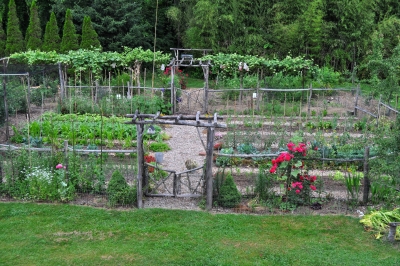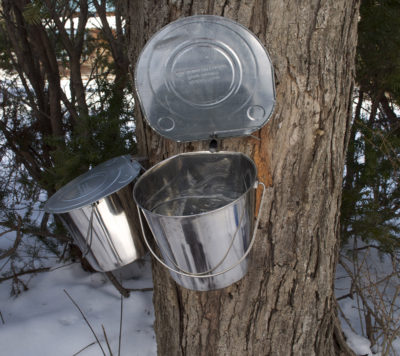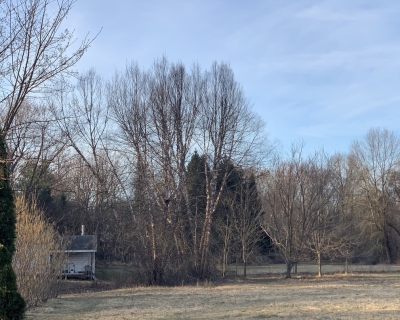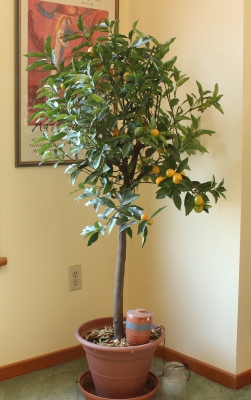HOW ABOUT THOSE OLD SEED PACKETS?
/7 Comments/in Gardening/by Lee ReichIt’s wasted effort to sprinkle dead seeds into furrows either in the garden or seed flats. Seeds are living, albeit dormant, embryonic plants which do not live forever.

When you buy a packet of seeds, you’re assured of their viability. Government standards set the minimum percentage of seeds that must germinate for each type of seed. The packing date and the germination percentage often are stamped on the packet. (The germination percentage must be indicated only if it is below standard.) I write the year on any seed packets on which the date is not stamped.
Your old, dog-eared seed packets may or may not be worth using this season. It depends on where the packets were kept and the types of seeds they contain. Last year I got tired of trying to decide how well my seeds were stored and which were still worth sowing; I took action.
Anti-Aging Treatments
Conditions that slow biological and chemical reactions also slow aging of seeds, i.e. low temperature, low humidity, and low oxygen. In years past, I’ve stored seeds in canning jars in my freezer, then moved the jars to the refrigerator as the freezer filled in fall. Powdered milk sprinkled into the bottom of the jars maintained low humidity. (Or so I assumed.) But all those jars took up lots of space, especially as my seed collections grew, and seed packets don’t pack well into canning jars.
As far as low oxygen storage, it’s not practical for most of us. I did try, one year, to create low oxygen seed storage by reversing gaskets and putting a one way valve on a bicycle pump. 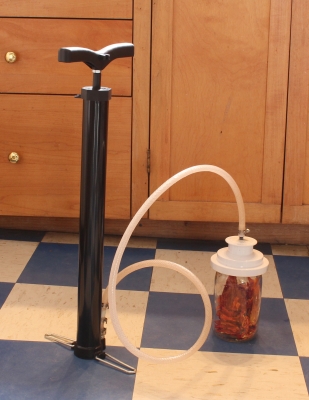 This allowed me to draw some of the air out of the jars with a tube connecting the pump to a ‘FoodSaver Wide-Mouth Jar Sealer.’ It did (usually) create somewhat of a vacuum but it was too much trouble to get at the seeds and re-seal a jar each time. And, again, seed packets don’t pack well into canning jars.
This allowed me to draw some of the air out of the jars with a tube connecting the pump to a ‘FoodSaver Wide-Mouth Jar Sealer.’ It did (usually) create somewhat of a vacuum but it was too much trouble to get at the seeds and re-seal a jar each time. And, again, seed packets don’t pack well into canning jars.
So last year I came up with a figurative “better mousetrap.” After much searching for a plastic, freezer-safe, air-tight, leak-proof, reasonably-sized tub for the bulk of my seeds — a stout order, all this — I came upon the ‘Komax Biokips 35-Cup Large Food Storage Container.’ Perfect!
I measured, cut, and hot-glued a piece of 1/4-inch plywood to run up the center of the tub to allow for two rows of seed packet. A couple of 100 gram silica gel packets in the tub at the end of each row keeps humidity low. The packets are easily rejuvenated in a warm oven for 20 minutes. I just measured the humidity in the tub (I like to measure); it’s a dry 17%.
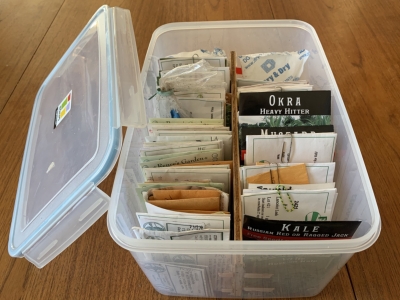
Moving the tub into the relative coolness of my basement in summer should maintain conditions in line with the guideline for seed storage that Fahrenheit temperature plus relative humidity should total less than 100. Come cooler weather in fall and then cold weather in winter, back the the tub goes to a shelf in my unheated workshop.
Worth Saving?
Seeds differ in how long they remain viable. Even with the best storage conditions, it’s not worth the risk to sow parsnip or salsify seeds after they are more than one year old. Two years of sowings can be expected from packets of carrot, onion, and sweet corn seed; three years from peas and beans, peppers, radishes, and beets; and four or five years from cabbage, broccoli, brussels sprouts, cucumbers, melons, and lettuce.
Among flower seeds, the shortest-lived are delphiniums, aster, candytuft, and phlox. Packets of alyssum, Shasta daisy, calendula, sweet peas, poppies, and marigold can be re-used for five or ten years before their seeds get too old.
In a frugal mood, I might do a germination test to definitively measure whether an old seed packet is worth saving. Counting out at least 20 seeds from each packet to be tested, I spread the seeds between two moist paper towels on a plate. Inverting another plate over the first plate seals in moisture and then the whole setup goes where the temperature is warm, around 75 degrees. After one to two weeks, I peel apart the paper towels and count the number of seeds with little white root “tails”.
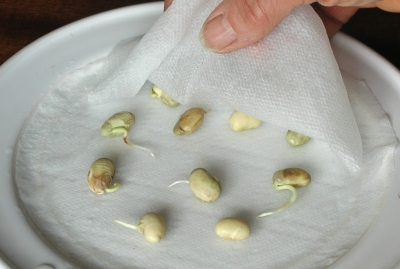
I figure the percentage, and if it’s low, the seed packet gets tossed into the compost pile (not given away!). Or, I might use the seed and adjust my sowing rate accordingly.
And the Record Is . . .
Among the shortest-lived seeds are those of alpine plants; their viability might plummet after only a couple of weeks.
As far as longest-lived seeds, there’s the story of the 10,000 year old lupine seed that germinated after being taken out of a lemming burrow in the Yukon permafrost. Alas, it’s only a story, one debunked by radiocarbon dating.
The true record for seed longevity was, until recently, 2,000 years, and was held by a date palm grown from seed recovered from an ancient fortress in Israel.
No one knows exactly what happens within a seed to make it lose its viability. Besides lack of germination, old seeds undergo a slight change of color, lose their lustre, and show decreased resistance to fungal infections. There’s more leakage of substances from dead seeds than from young, fresh seeds, so perhaps aging influences the integrity of the cell membranes. Or, since old seeds are less metabolically active than young seeds, the old seeds leak metabolites that they cannot use.
(The above was adapted from my book The Ever Curious Gardener: Using a Little Natural Science for a Much Better Garden available from the usual sources and, signed, from me.)
OUTDOOR MAPLES AND INDOOR KUMQUATS
/23 Comments/in Fruit, Houseplants/by Lee ReichSap Season
Get your taps in. It’s syrup weather. Maple syrup. At least here in New York’s Hudson Valley, the sunny days in the 40s with nights in the 20s that are predicted should get the sap flowing.
I say “should” because I haven’t yet checked sap buckets that I hung out on the trees a few weeks ago when winter temperatures suddenly turned warm; it was sap weather back then. That day was hopeful: I drilled holes an inch and a half deep, lightly hammered in the spiles, hung buckets, and attached covers over the buckets. Frigid days and nights that descended soon after that kept sap flow in abeyance.
My “sugar bush” amounts to only three sugar maple trees. I used to have four, but a large tree that was a truly magnificent representative of its species began an irreversible path to its death.
“Maple decline” is a disease complex brought on by some combination of drought, soil compaction, road salt, root damage, and air pollution. Upper branches are usually the first to go, and once decline begins, secondary fungi and insects speed the process along.
I’m not sure about my tree, though, because its lower branches were the first to go. Also, the tree grows along the back edge of my property, where it’s been shielded from those usual causes for decline.
One more contributor to decline is overtapping. I plead not guilty. My fading tree was larger than the 8 or10 inch minimum diameter for tapping, and I only tapped it once, when the tree, it turned out, was already going downhill. The lack of sap flow was what prompted me to see all this. And then I noticed many rows of sapsucker holes in the bark.
Long story short: The tree became firewood.
My three other, healthy maples might yield me only a quart of finished syrup. The reasons? One quart is enough for me, so I’m tapping only one of them. Also, they’re relatively young. I planted those three trees about 25 years ago, and they’re now only about 8 inches in diameter.I highly recommend planting trees, for their beauty, for what food they might offer, and for the mere satisfaction of watching the plants grow. Especially if they are small when planted. Small trees also establish quickly to require less aftercare, often soon outgrowing their initially larger compatriots. Those three maple trees? From one perspective, it seems like a long time ago that I dug holes and set the saplings in the ground; from another perspective, it seems like I planted them, walked away, then turned right around to find that these young ‘uns have grown into bona fide trees!
Birch Sap
I may end up with more sap than planned, but not maple sap. Along with the three sugar maples I planted way back when, I also planted three river birches (Betula nigra). They grow, appropriate to their name, in a wet area just out of a swale through which water runs in spring, each a clump of a half dozen or so sturdy trunks reaching skyward to about 35 feet.
Maple might be the heaviest sap producing tree, but it’s not the only kid on the block. Many people tap their black walnut trees. Call me provincial, but black walnut syrup, much as I love the nuts themselves, has no appeal me even though I’ve never tasted it.
Birch syrup though . . . mmm. Never tasted that one either, but it sounds good. Three birch taps should offer an ample amount for tasting.
What a Funny Name
I don’t need to see the small, pebbly-skinned, orange orbs on grocers’ shelves to know that it’s kumquat season. My own Meiwa kumquat is looking very pretty, with a good crop of fruit staring out from their backdrop of glossy, forest-green leaves. I’ve trained the plant as a “standard,” that is, as a miniature tree with a crown of branches perched atop a four foot trunk.
The present crop is my best ever, and traces its success back to last spring. In previous years, I was too timid with pruning. And pruning is necessary, every year. Pruning keeps the plant from growing disproportionately large for its pot -– or my house — and coaxes growth of new, fruiting wood.The roots also get pruned each year to make space for new potting soil for root growth and nutrients. I laid down the plant and pot to easily slide out the root ball. After slicing an inch or two of roots and potting soil from all around the outside of the root ball, back into the pot the plant went, with new potting soil packed in the space between the shaven root ball and the inside edge of the pot. The seemingly brutal treatment took place last year just as the garden awoke in yellow blossoms from daffodils.
As soon as weather warmed, new sprouts began to grow. By midsummer, the plant was fragrant with blossoms. By late summer, little, green fruits were forming which, with careful watering, survived the environment change as the plant moved indoors in October. The plant stood at attention in a sunny window in the cool bedroom for weeks, and a couple of months ago, the fruits started turning orange. They are now ripe and delicious!
WEED-LESSNESS FOR 2021
/0 Comments/in Gardening/by Lee ReichWEEDLESS GARDENING WORKSHOP/WEBINAR
with Lee Reich, PhD, writer, scientist, and farmdener*
Introducing a novel way of caring for the soil, a 4-part system that minimizes weed problems and maintains healthy plants and soil. Learn how to apply this system to establish new plantings as well as to maintain existing plantings. The principles and practices are rooted in the latest agricultural research and are also applicable to sustainable, small farm systems.
This system works because it emulates, rather than fights, Mother Nature who, as C. D. Warner wrote (My Summer in the Garden, 1887), “is at it early and late, and all night; never tiring, nor showing the least sign of exhaustion.”
Date: February 22, 2021
Time: 7-8:30 pm EST
Cost: $35
Register for this webinar at:
https://us02web.zoom.us/webinar/register/WN_WqSCBtOGTqqjGgbOHOuxfg
After registering, you will receive a confirmation email containing information about joining the webinar.
*A farmdener is more than a gardener and less than a farmer.
